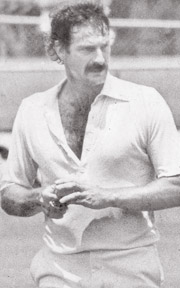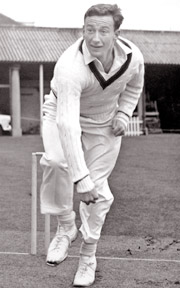The decade of the quickies
By A.C. De Silva
Talk of cricket and one question that will eventually prop up will be
the pace bowlers. There has been a lot of cricket in the past few
decades and particularly the seventies have been the fast bowlers'
decade. English fast bowler Bob Willis has been one fast bowler who has
seen plenty of them at close quarters. Willis says that his Test place
in the England team has not be relied on his ability to bat against
them, because they're been a good formidable bund.
|

Dennis Lillee – A great tactician, his slower bakk a beauty,
he can send down a surprise fast leg-breaks and off a 2-yard
run can bowl a quick bouncer too. |
|

Graham McKenzie – His relaxed run up and graceful movements often came as
a surprise to see the ball rise sharply from the wicket. |
|

Jeff Thomson – He has a unique bowling action with the
right-arm coming from behind the right knee so that the
batsman sees the ball very late. |
The physical characteristic of his selections has interested him -
the four Australians are well built, with stamina to see them through
the most exacting demands of five-day Tests. Two of his West-Indian
choices are comparatively slim, while the English ones are also supple
and wiry. Then there's the South African Mike Procter who is class by
himself.
The most interesting point about his selections is hardly any of them
confirm to the classical standards laid down by the cracking manuals.
Some have unorthodox deliveries like Procter - others somewhat poor
run-ups (Daniel), Andy Roberts of the West Indies has a slightly
round-arm action, John Snow of England isn't completely orthodox at the
moment of delivery - but despite these somewhat difficulties, they can
bowl fast. So, the young hopefuls should be careful about how they cope
with the above slight short comings of the pace bowlers.
Dennis Lillee
One of the greatest fast bowlers that played around the time that
Willis of England was playing is Dennis Lillee of Australia. He's
achieved more movement in the air and off the pitch at high speed than
any other quickie since the second World War. Lillee is proof of the
crowd-pulling aura of a fast bowler, he plays to the crowd and the crowd
helps him to get the best and nobody seems much bothered about the
slow-over-rate when Lillee has the ball.
He has a superb high-action, with both feel off the ground at the
crucial final leep before delivery. This high action means he can bowl a
wicket-taking outswinger. A great tactician, his slower ball has become
a beauty. He can bowl round the wicket, send down surprise fast
legbreaks, and off a two-yard run can bowl a very quick bouncer.
Lillee's follow through is fine and he can get close to the stumps to
vary his line of attack. He made a great recovery from a terrible back
injury in 1973 and has bowled for long periods at high speed. A case in
view was the Melbourne Centenary Test, where he practically beat
England, Single-handed.
His run-up, though characteristic of his long-bursting aggression
isn't an ideal one.
Test record: 48 Tests, 11,289 balls, 5,169 runs, 251 wickets, 20.59
average.
Jeff Thomson
Jeff Thomson is a great fast bowler with all the right assets -
temperament. Action, pace, movement and strength - he's proof that
unorthodox methods pay off. A fine bowling action, with the right-arm
coming from behind the right knee so that the batsman sees the ball very
late.
For the better part of the seventies, 'Thommo' rode the international
arena like a colossus. He gave a torrid time to those who faced him in
the middle. In the deadly company of Dennis Lillee, Thomson put the
Aussies right on top.
A fearsome combination which made Clive Lloyd think and act... that
pace and pace alone would be the way for glory. A play that later worked
wonders for the 'Supercat'.
Tall and powerfully built, Thomson, in his early days, was a junior
national javelin thrower and a surf rider. Therefore, there is no
surprise that he 'hurled' the ball from behind at the last minute.
After an unsuccessful Test debut against Pakistan in 1972-73 in that
series he played with a fracture in his foot-Thomson struck lethal blows
against Mike Denness' Englishmen and Lloyd's West Indians.
Enviable record
In his first Test against Pakistan, Thomson had none for 110 in two
innings. But he came with telling strides against England at home in
1974-75. A performance that brought him 33 wickets from five Tests (he
missed the second innings of the fifth Test due to injury). Needless to
mention, every Englishman who faced Thomson and Lillee was like a cat on
a hot tin roof.
A relaxed tiptoe approach to the crease, he saves his strength for
that gloriously explosive final leap and the ball's delivered from a
perfect side-on position. He seems to bowl more unplayable balls than
other fast bowlers, his fast yorker is somewhat frightening, and unlike
Lillee he bowls few bouncers.
Fine temperament, doesn't worry about dropped catches and never gave
his captain any trouble.
Test record: 22 Tests, 5,083 balls, 2,607 runs, 103 wickets, average:
2531.
Graham McKenzie
Graham McKenzie's last Test match was the first Test of Bob Willis,
so Willis says that he had an early glimpse of a fine athlete. McKenzie
had a glorious action.
His run-up was so relaxed, his movements so graceful, that it often
came as a surprise to see the ball rise off the wicket so sharply.
The power came from those wide shoulders and that some what
magnificent physique, all from a very short run-up. Nothing riled him,
the demands of his captain were always met with unselfish good humour,
and he'd loved to bowl all day.
A great physical fitness man, any fast bowler would do well to study
McKenzie's example of keeping in shape through an ardons decade of fast
bowling.
His marvellous side-on action meant he could bowl excellent late
outswingers, and although he's be the first to admit his luck in having.
A first slip like Simpson and a wicketkeeper like Grout in the
Australian side for many years, no world-class batsman could feel safe
against a bowler who in his prime was a wonderful sight.
He was somewhat overbowled by too many captains. He lacked 'devil',
that vital element that makes Lillee so great.
Test record: 60 Tests, 17,604 balls, 7,328 runs, 246 wickets, average
29.79.
|

